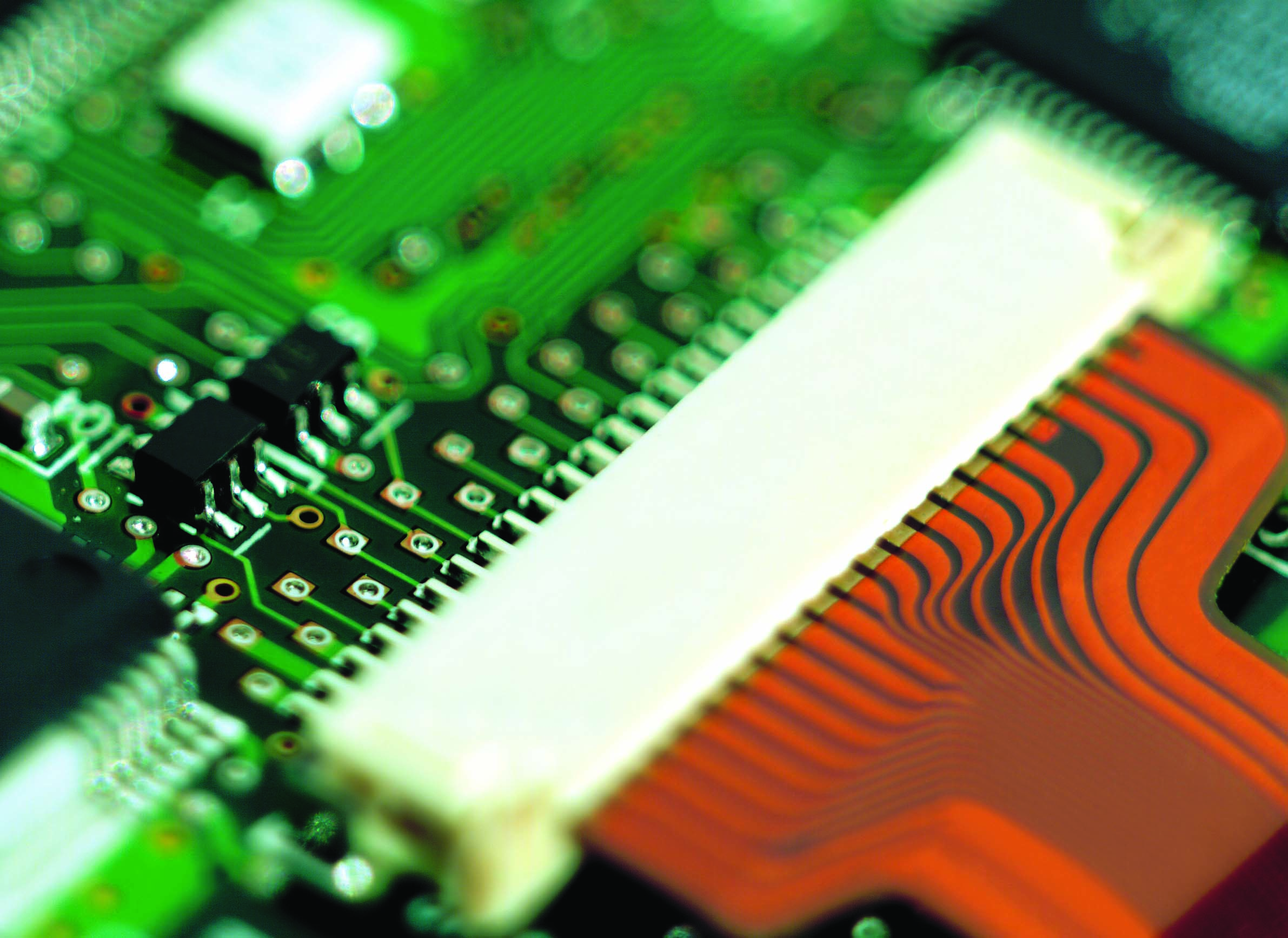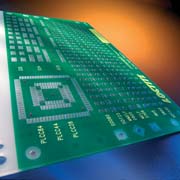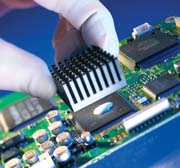
Surface-Mount Adhesive (SMA)
Used in both wave and reflow soldering processes to maintain component positioning on the PCB, the SMA's greatest challenge is to survive the thermal shock of transitioning from preheat to soldering temperatures, which requires a combination of good adhesion, strength, and flexibility. Low moisture pickup properties are essential to prevent voiding in the SMA, and it needs to exhibit high visual contrast for easy detection against substrates. As the SMA remains on the PCB during its operating life, it must survive any extremes of operating conditions without compromising circuit reliability, so it should possess good cured electrical properties and pass the IPC tests for corrosion and SIR.The latest products added to the electronics group of Henkel's SMA range are Chipbonder 3621, for high-temperature and high-humidity conditions, and Chipbonder 3627, which offers rheology specifically designed for high-speed printing and dispensing. Low-temperature-cure adhesives such as Chipbonder 3619 were originally developed for high-speed dispensing onto temperature-sensitive components, but another consideration has boosted its popularity: energy conservation. With new legislation imposing additional taxation burdens on corporate energy users, manufacturers are choosing products that best enable them to reduce curing oven temperatures. Given its cost-saving properties, the Chipbonder line effectively pays for itself.

Electrically Conductive Adhesive (ECA)
ECA provides both a mechanical bond and an electrical interconnection between a device and a circuit board, and is a lead-free alternative to solder. It is used for bonding temperature-sensitive components, assembly and repair of flexible circuits and connectors, and to provide electrical connections on non-solderable substrates such as plastics or glass. Isotropic ECA conducts electricity along all axes and can replace solder on thermally sensitive components or devices requiring a ground path. Anisotropic ECA allows current flow along one axis only, providing electrical connectivity and strain relief for flip-chip devices.Stability and shelf life are potential issues with single-component ECAs, which usually require storage at -40°C. The isotropic epoxy adhesive Loctite 3880 is an exception, offering the advantage of shipping and storage at refrigerator rather than freezer temperatures.

Thermally Conductive Adhesive (TCA)
TCA provides efficient thermal transfer between devices and heatsinks and adds structural support, eliminating the need for mechanical fasteners and clips. It provides a convenient alternative to a phase-change thermal interface material (PCTIM), where the latter's extremely low thermal impedance is not essential. TCA is also useful for repair if a BGA becomes detached from its substrate through vibration, or perhaps through flexing of touch pads by key pressing. TCA can be used effectively on any electronic device that requires a heatsink to be bonded to a chip, microprocessor or transistor. Typical applications include ASIC devices, power transistors, BGAs, PGAs, MCMs and some DIP devices. One of the most versatile TCAs in the electronics group of Henkel's range is Loctite 3874, a single-component, acrylic material for bonding heat-generating devices to thermal spreaders. Supplied without self-shimming glass beads, the material offers fast curing and one of the highest conductivities in its class.For more information, visit http://www.henkelelectronics.com.
Side Bar: Tackling the Pb-free basics
As the European Union's Restriction of Hazardous Substances Directive (RoHS) nears, the following is a look at the basics.By Steve Dowds, Global Product Manager, the electronics group of Henkel
Why Must We Go Pb-free?
The law is set to stipulate lead-free electronics manufacturing. Irrespective of the merits or demerits of the case, with effect from July 2006, the EU's Restriction of Hazardous Substances Directive (RoHS) comes into force. This directive bans the use of lead, mercury, cadmium and hexavalent chromium in nearly all electronic and electrical products produced or sold inside the EU. It also bans the use of brominated flame retardants in PCBs, which has received little attention so far.Are There Exemptions?
The RoHS Directive lists the following exemptions.1. High-melting-point solders containing more than 85% Pb.
2. Servers, storage and storage array systems (exempt until 2010).
3. Network infrastructure equipment for switching, signalling and transmission, as well as network management for telecommunication.
4. Pb in electronic ceramic parts, such as piezoelectronic devices.
Which Alloy to Use?
Over the past decade a number of studies have examined the feasibility of various Pb-free alloys. All alloys selected for consideration use tin as a basis, as this is the active ingredient in most soft solders with good wetting and bonding properties. It melts at 232°C and is non-toxic to humans. The addition of other elements including zinc (Zn), indium (In), silver (Ag), copper (Cu) and bismuth (Bi) bring down the melting point. Broadly speaking, three alloy types stand out as promising candidates: SnAgBi, SnZn, SnAgCu.Alloys containing bismuth are risky when used in conjunction with Pb-bearing components since Sn, Pb and Bi form a low melting phase at 96°. In the worst case, this could mean components falling off the board under thermal cycling. However, SnAgBi alloys do have two advantages: a relatively low melting point of 200-210°C, and wetting properties similar to SnPb.
SnZn melts at 199°C, which is close to the melting point of SnPb. Unfortunately, Zn reacts with both acids and bases; when mixed with flux medium, it shows poor stability. Shelf life is days rather than months, and there is also concern regarding long-term reliability of the assembly once soldered. Almost universally the conclusion is that SnAgCu (also known as SAC alloy) is the most suitable replacement as long as Pb is in the system. Once Pb is eliminated, SnAgBi may prove a better choice due to the lower melting point and improved wettabililty.
Explain the differences.
There are a number of SAC alloy compositions available including 3.8Ag, 0.7Cu, 4Ag 0.5Cy, 3Ag 0.5Cu, with Sn forming the balance of the alloy. All have broadly the same melting range and exhibit the same microstructure. Manufacturing tolerances on minor constituents are typically ±0.2%, so you could order 3.8/0.7 and get 4.0/0.5 with no effect on performance. According to the IPC solder product value council (SPVC) there is no substantive difference between these marginally different compositions.Various competing patents are in place, though none has been tested in court yet. So, before selling any product manufactured using a Pb-free alloy, manufacturers should check with their materials supplier that arrangements are in place to avoid patent infringement.
What are the Pricing Implications?
Unfortunately, all Pb-free alloys cost more than SnPb. While SnPb alloys are around 63% Sn, lead-free alloys are 95% Sn. Not only are raw-material costs substantially higher for Sn, demand for Sn has increased over the past year. Tin prices have risen from $4,500 per ton in April 2003 to a peak of $10,000 in May 2004.This will have an immediate effect on solder bars where little value is added to the material. In the case of solder paste, the effect will be less since much of the cost results from added value activities such as processing into powder. However, if the price remains high it will feed through into paste prices eventually.
At the moment, Pb-free is typically 40% more expensive than SnPb per kg. On the plus side, however, the mass density of SnAgCu is lower than SnPb by about 12%, so users get 12% more volume of paste per kg and 12% more joints.
Is Pb-Free More Reliable than SnPb?
Initially, there was an assumption that the superior bulk alloy properties of SnAgCu, when compared with SnPb, would mean better reliability joints in real assemblies. As a bulk alloy, SnAgCu is superior to SnPb in many respects, with higher strength, better creep resistance and longer fatigue life. Unfortunately, when tested on real assemblies that is not always the case. If an assembly is subjected to a high strain rate over a wide temperature range (-55-125°C), results show that SnPb is better; if subjected to a lower strain rate over a less taxing temperature range (0-100°C), Pb-free appears to be better.Are there Differences in the Manufacturing Process?
In terms of material shelf life, open time and tack there is no obvious difference between SnPb and Pb free. The major difference is reflow since higher peak temperatures are required. Sn63 Pb37 melts at 183°C with a peak temp of 205-220°C. SnAgCu melts at 217°C, so a higher peak temperature is required, typically 230-260°C.Naturally, this heat is not good for components, so when evaluating solder paste it is best to find a paste that gives maximum wettability with minimum superheat. It is possible for small boards with minimum delta T to reflow with a peak temperature of 229°C; however, assemblies with a large thermal mass, such as backplanes and motherboards, present more of a challenge. For PCBs with a delta T of 20 to 25°C, it may be necessary to have a peak temperature of 260°C in order to ensure good reflow across the board.
Where do I start?
Time is short since the implementation date is a year away. Here are some useful resources that can offer help.The electronics group of Henkel offers manufacturers support and advice across the PCB, from solder materials including lead-free alloys to die attach adhesives, underfill products, encapsulants, and PCB coating materials.
